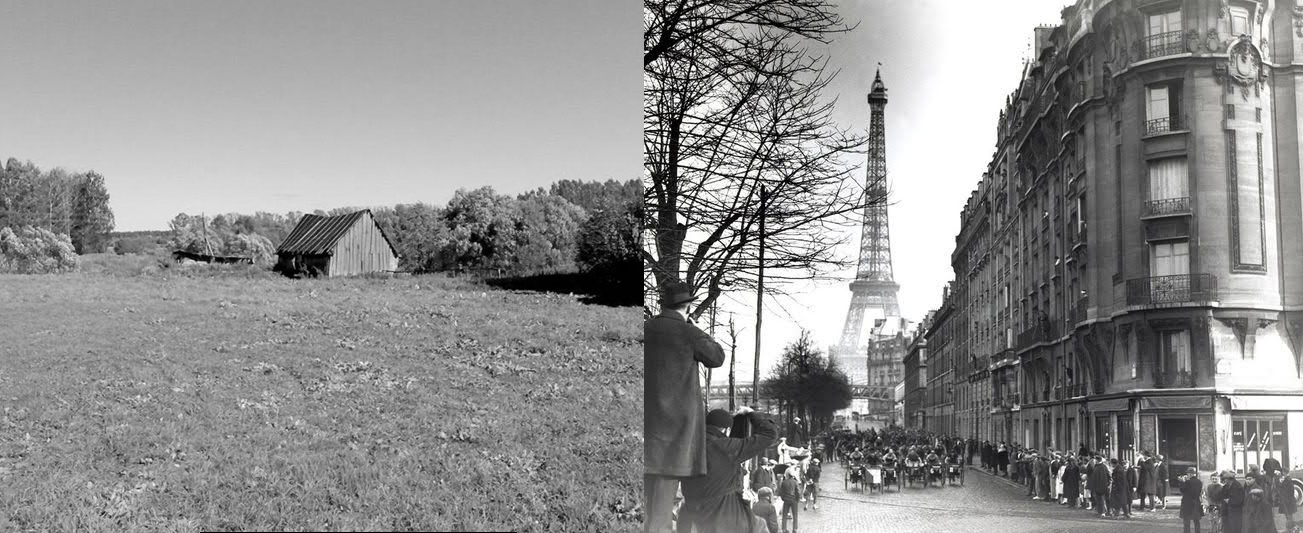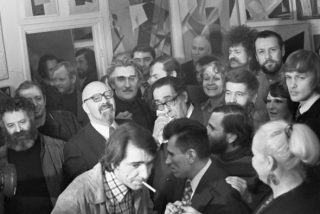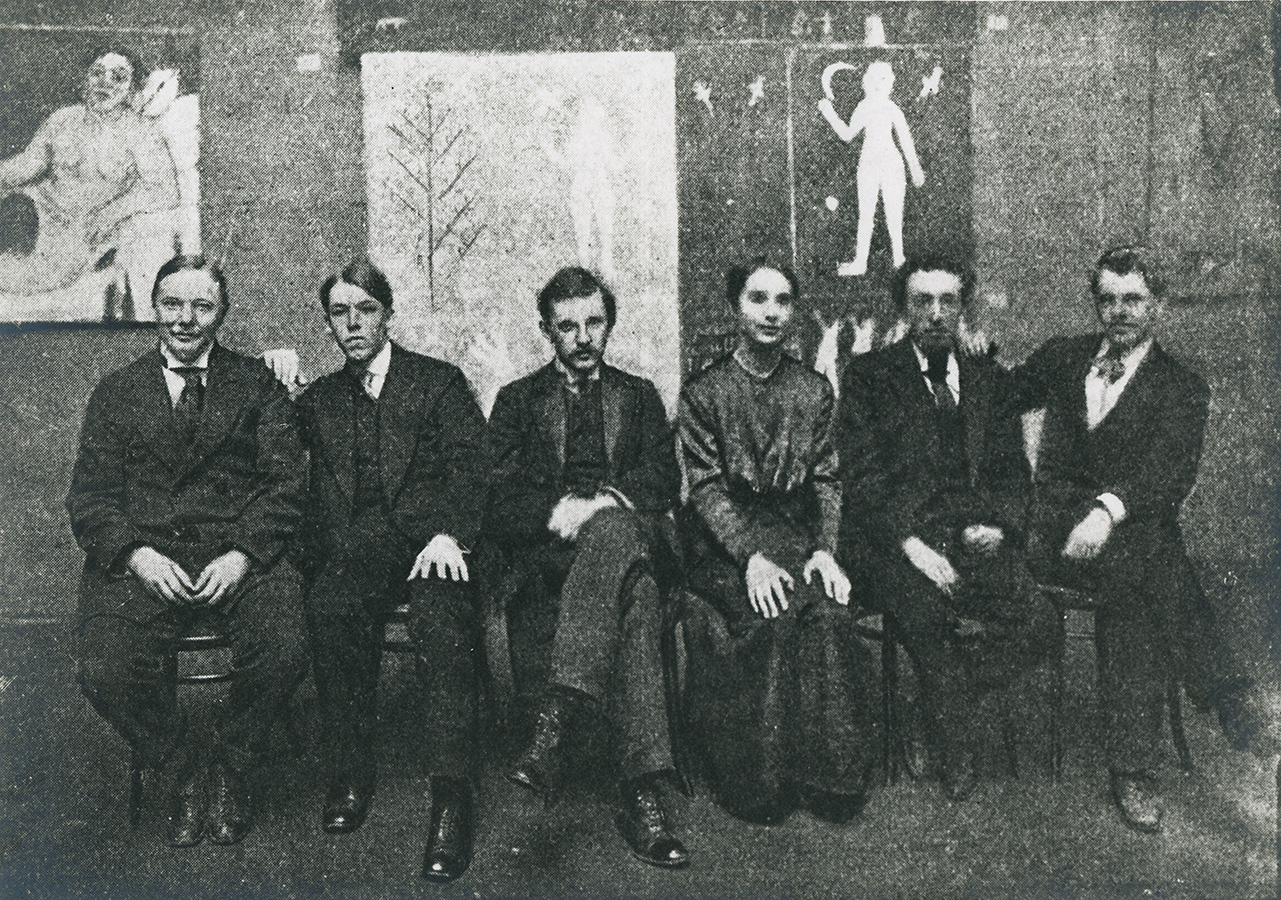Natalia Gontcharova Timeline
From pastoral childhood in rural Russia through controversial youth in Moscow to wide-ranging artistic creation in a Paris studio and beyond: A year-by-year listing of the major events in the extraordinary life of Natalia Gontcharova.
1881
Natalia Sergeevna Gontcharova born in Tula province in Russia, outside of Moscow (June 21).1
1892
Sent to Moscow for formal education at Fourth Grammar School for Girls.2
1898
Graduates from school, explores careers in Botany, Medicine, History and Zoology.3
1899
Begins sculpture studies at the Moscow studio of V. Chernyshov.1
1900
Meets fellow art student Mikhail Larionov (1881-1964).3
1901
Enrolls as part-time student of sculpture at Moscow School for Painting, Sculpture and Architecture under Pavel Trubetskoi.3
1903
Travels to Larionov’s hometown of Tiraspole and spends the summer sailing the Crimea with him.4
Stops attending classes at Moscow School (with the help of a medical certificate from her Uncle).5
Begins oil painting, private study under Konstantin Korovin.
1903-4
First exhibition – sculpture work displayed in showcases with other Moscow School students.3
1905
Introduced to Sergei Diaghilev, art critic, patron, World of Art co-founder and founder of the Ballets Russes.1
1906
Spends summer at Panino estate near Vyazma.5
Exhibits pastels (alongside Larionov) first in Moscow, then as part of Diaghilev’s exhibition of Russian Art at the Salon d’Automne in Paris, France.
Exhibits pastels at the last (1st period) World of Art show with Dobuzhinsky, Benois et al.6
Paints first primitivist pieces.
1906-7
Diaghilev shows Gontcharova works as examples of Russian Post-impressionism at further exhibitions in Paris, Berlin and Venice.
1907
Expelled from the Moscow School for failing to pay tuition, then later reinstated and awarded silver medal.6
Spends summer at family estate in Kaluga Province.6
1908
Takes part in The Golden Fleece Salon Exhibition in Moscow, featuring local artists juxtaposed with those from France.
Begins teaching at Ilya Mashkov and A.N. Mikhailovsky’s School of Art.
Spends Summer back in Tula Province, paints series of landscape and peasant pieces.
1909
Expelled (again) from the Moscow School for failing to pay tuition.3
Exhibits in 2nd and 3rd Golden Fleece Salon exhibitions in Moscow.5
Commissioned for set and costume design for Hugo von Hofmannsthaal’s Die Hochzeit der Sobeide at Konstantin Korovin’s studio.3
1910
Invited to contribute to Union of Youth exhibition in St. Petersburg.1
During exhibition at Society for Liberal Aesthetics in Moscow has 3 nude studies confiscated as alledged pornography.5
Tried for ‘offending the public morals’, found not guilty.5
Turns away from Impressionism, joins with Larionov to form radical arts collective Jack of Diamonds.1
Presents earliest Primitivist and Cubist works via Jack of Diamonds exhibitions.7
1911
Gontcharova and Larionov leave Jack of Diamonds, form Donkey’s Tail group.1
In open letter formulating Donkey’s Tail goals, Gontcharova refers to herself as the first woman cubist.
Contributes to 2nd Union of Youth exhibition.1, 6
Contributes to World of Art Exhibition in Moscow.1, 4
Painted almost 80 pictures in this single year alone.6
1912
Promenades through city topless, Paints face at Pink Lantern and No. 13 Cabarets in Moscow.3
At first (and only) Donkey’s Tail exhibition, Gontcharova’s paintings seized by the police after order issued from Holy Synod.3, 4
Contributes to 3rd Union of Youth exhibition.1
Works shown in exhibitions in Munich, Berlin and London.
Begins working in the Cubo-Futurust and Rayonist/Rayist styles.1, 6
Begins working as both a book illustrator (for Velimir Khlebnikov and Alexei Kruchenykh) and a fashion designer for house of Nadezhda Lamanova.3, 6
1913
Gontcharova and Larionov organize Target exhibition in Moscow, exhibit Rayonist works for the first time.4
At public debate at Polytechnic Museum in Moscow, Gontcharova tells crowd that they are “nothing more than a herd of sheep”.1
Illustrates books for Sergei Bobrov and Konstantin Bolshako.6
Exhibition of Rayonist and Futurist works in Der Erste deutsche Hernstsalon at Der Sturm gallery in Berlin.
Major retrospective showcases 768 Gontcharova works at Claudia Mikhailova’s Art Salon in Moscow.1
1914
Gontcharova and Larionov star in a Futurist film by Vladimir Kasarov, Drama in the Futurist’s Drama No. 13.
Major Gontcharova retrospective of 249 works presented in St. Petersberg.3
16 Religious works are again confiscated then returned after vociferous defense in the local press by Mstislav Dobuzhinsky and others.3
Gontcharova, Larionov help organize major avant-garde exhibition in Moscow (No. 4 Futurists, Rayonists, Primitive).4
Travels to Paris with Larionov to help install the sets she designed for Diaghilev’s Ballets Russes productions (leaves Moscow on April 29).
The production of Le Coq d’Or is a great hit and Gontcharova is fêted for her sets and costumes.
Exhibition of Larionov and Gontcharova’s paintings held at Galerie Paul Guillaume.3
Returns to Moscow after Larionov is conscripted into Russian army at outbreak of WWI (leaves France on August 1).3
Larionov sent to Eastern Front, injured by an exploding shell on October 1 and hospitalized.1
Gontcharova publishes collection of 14 lithographs entitled Mystical Images of War with V.N. Kashin.4
1915
Larionov discharged from Russian army after recovery in Tiraspol military hospital.2
Gontcharova completes scenery and costumes for Carlo Goldoni’s Il Ventaglio at Moscow’s Kamerny Theatre.4
Larionov and Gontcharova exhibit alongside Chagall, Kandinsky, Falk & Malevich at The Year 1915 Exhibition in Moscow.4
Gontcharova and Larionov leave Russia in June to travel via Finland, Sweden, Norway, Britain and France and join Diaghilev and his Ballets Russes in Ouchy (near Lausanne, Switzerland).3
Gontcharova has initial talks with Igor Stravinsky about working on his new ballet Les Noces.3
Begins work on Liturgie, a ballet conceived by Diaghilev to the music of Russian Orthodox Hymns.
1916
Gontcharova and Larionov move back to Paris.3
Gontcharova begins work on Espagnoles/Spanish Ladies series during summertime trip to San
Sebastian in Spain with Diaghilev’s ballet company.5
1917
Accompanies Diaghilev’s ballet company to Rome from January to May with Larionov.
Meets Pablo Picasso, Giacomo Balla, Fortunato Depero.5
Spends summer in Florence, Venice and Turin, returns to Paris in August, meets Nikolai Gumilyev.1
Russian Czar deposed in October Revolution, Larionov and Gontcharova impoverished after keeping life savings in Russian Roubles (which plumeted in the Revolution’s aftermath).1
Goncharova’s house in Moscow “nationalized” – paintings removed by Nikolai Vinogradov & stored in his ‘State Picture Depot’ (AKA his attic!).3
1918
160 of Gontcharova’s theatrical works exhibited alongside Larionov’s at Galerie Sauvage in Paris.1
Larionov and Gontcharova on list of 143 artists whose works should be purchased with state funds to establish collection of contemporary art to celebrate the Revolution in new Moscow Museum of Artistic Culture.1
Gontcharova and Larionov spend 10 months at Count Ignatieff’s estate in central France to escape the bombing of Paris.3
1919
Gontcharova and Larionov return to Paris in May and move into the apartment on the Rue de Seine (later renamed Rue Jacques Callot) that becomes home for the rest of their lives.3
Gontcharova also rents a nearby attic room on Rue Visconti to use as a studio.3
Began conducting business at the Le Petit St-Benoit cafe.1
Natalia’s theatrical works exhibited alongside Larionov’s at Galerie Barbazanges in Paris.7
Rodchenko purchases large number of Gontcharova and Larionov works for Russian Museum of Artistic Culture.1
1920
Exhibits at the Biennale in Venice, and alongside Larionov at the Exposition Internationale d’Art Moderne in Geneva.3
Gontcharova and Larionov jointly illustrate Valentin Parnakh’s Moltdynamo.5
1921
49 works shown at Russian Arts and Crafts exhibition at Whitechapel Gallery in London.5
Ilya Zdanevich arrives in Paris.4
1922
Takes on spacious studio in Rue Visconti, gives lessons.
Contributes to traveling exhibition of theatrical art that visits Amsterdam, London, Manchester, Glasgow and Bradford.5
Exhibits alongside Larionov at Kingore Gallery in New York.4
Designs costumes for Kikimora Theater in Berlin.4
Commissioned to decorate the home of conductor Serge Koussevitzky in Paris.5
Begins designing for Marie Cuttoli’s fashion house Maison Myrbor on the Rue Vincent in Paris.1
1923
Exhibits with Larionov in Brussels and Tokyo.4, 3
Decorates Grand bal des artistes travesti-tranemental at Salle Bullier in Paris.
1924
Designs invitations for Larionov’s Bal Banal in Paris.
Designs sets and costumes for Yulia Sazonova’s Puppet Theatre.3
1925
Decorates Bal de la Grand Ourse in Paris.3
1926
Polypytych of Spanish Women presented at Internationale Kunstausstelung in Dresden.3
Designs sets for Mussorgsky’s The Fair at Sorochyntsi in Paris.5, 8
Commissioned by Diaghilev to create new sets and costumes for London production of Le Coq d’Or.5
1927
Tretyakov Gallery & Russian Museum acquire series of works by Larionov and Gontcharova via Lev Zhegin.3
Nikolai Punin opens permanent exhibition of avant-garde art at Russian Museum.5
Zhegin sends remaining works in Russia to the artists in Paris.3
1928
Becomes close friends with poet Marina Tsvetaeva in Paris (whom she had briefly met as a child in Moscow).3
Begins to Summer on the French Riviera.
Opening of Modern French Art exhibition at Tretyakov gallery, featuring many works by Russian emigre artists.1
1929
Sergei Diaghilev dies.3
1931
Creates costumes for La Petite Catherine by Alfred Savoir at Theater Antoine in Paris.1
One-woman show at Galerie L’Epoque features 33 Gontcharova works.5
Exhibits at Salon des Independents in Paris.3
1932
Designs costumes with Larionov for Sur le Borysthene by Sergei Prokofiev at the Paris Opera.
Executes production of Rimsky-Korsokov’s Tsar Saltan at Lithuanian State Opera, Kaunas (with old friend Mstislav Dobuzhinsky acting as the production’s Art Director).3
Central Committee of Communist Party assumes control of all artistic organization & administration in Russia.9
1933
Exhibition at the Salon d’Automne in Paris.3
1934
Begins designing sets and costumes for Vasily Voskrezensky/Colonel W. de Basil’s Ballets
Russes de Monte Carlo 3 (which changed its name in 1938 to the Ballet Russe de Monte Carlo when Léonide Massine became artistic director).5
2 years after Stalin’s repudiation of ‘formalism’ in the arts, final decision made to purge everything but works of official Soviet Socialist Realism from all state art collections in Russia, works sent to provincial museums or destroyed.1
1936
Participates in Alfred Barr’s Cubism and Abstract Art exhibition at Museum of Modern Art in New York.1
1937
Commissioned by Voskrezensky/de Basil to design sets and costumes for new version of Le Coq d’Or at London’s Covent Garden.5
1938
Gontcharova-designed sets and costumes a huge hit for Voskrezensky/de Basil’s Cinderella at London’s Covent Garden.
Voskrezensky/de Basil’s Ballet Russe de Monte Carlo show Bogatyrs successfully premieres at Metropolitan Opera in New York.3
Gontcharova and Larionov become French citizens.3
1939
Espagnoles-Magnolias exhibition at Galerie Cadran in Paris.4
Spanish Civil War ends; World War II begins.
1940
Paris is taken by the Nazis and occupation begins.
1941
Exhibits with Larionov at Salon des Tuileries in Paris.3
1943
Exhibits with Larionov at Salon des Tuileries in Paris.3
1944
Designs stage decorations and costumes for Sorochinsk Fair by Mussorgsky at Salon Pleyel in Paris.1
1945
After World War II ends and Iron Curtain falls, Gontcharova and Larionov live in relative obscurity and poverty in Paris.
1950
Larionov suffers stroke in London, forced to stay in sanatorium/nursing homes there and in Paris at great expense, almost causes bankruptcy; Gontcharova begins illustrating books again, and to sell works to museums to support them both.4
Long walks from the apartment to visit Larionov in Chatenay-Malabry triggers decline in Gontcharova’s health.1
1952
Solo retrospective of Gontcharova’s theater works at Galerie de l’Institut in Paris.
1953
Galerie 5 exhibition in Paris.
1954
Major Diaghilev exhibitions in Edinburgh and London gains both Larionov and Gontcharova renewed attention.8
Tate (London), National (Edinburgh) galleries lead institutions buying Gontcharova works for their permanent collections.
Gontcharova commissioned to redraw designs for new productions of L’Oiseau de Feu and Les Noces in London and Milan.3, 4
1955
Larionov and Gontcharova marry at town hall of the 6th Arrondissement to protect their artistic legacies in the event of either of their deaths (June 2).3
1956
Exhibition of new Rayonist works at Galerie d’Institut in Paris.4
The Cat (1913) purchased by Guggenheim Museum in New York.
1957
Despite severe bout of rheumatism, designs sets and costumes for six ballets in memory of Michael Fokine at festival in Monte Carlo.3, 5
Begins work on series of cosmic paintings, inspired by launch of Sputnik I satellite (October 4).1
1958
‘About 20’ of Gontcharova’s Sputnik paintings exhibited by Eduard Loeb in his Gallerie on the Rue de Rennes.4
1959
Gontcharova and Larionov show works at Beitrag der Russen zur Moderne Kunst in Frankfurt, Germany.3
1961
Led by the efforts of Mary Chamot and Camilla Gray, the Arts Council of Great Britain organizes influential major retrospective show for Gontcharova and Larionov.1
1962
Larionov re-admitted to hospital.1
Natalia Gontcharova dies of cancer in Paris (October 17) and is buried according to the rites of the Russian Orthodox Church at a cemetery in the suburb of Ivry-sur-Seine, southeast of the city (October 22).3, 4
1963
Larionov marries long-term lover/assistant/mistress Alexandra Klavdievna Tomilina (May 28).1
Larionov and Gontcharova retrospective exhibition mounted at Musee d’art moderne de la Ville.1
1964
Mikhail Larionov dies, buried in double plot next to Gontcharova in Ivry-sur-Seine (May 10).3
Tomilina assumes control of the estates of both Larionov and Gontcharova.
Tomilina begins transferring works from Gontcharova and Larionov from the apartment/studio into Odoul warehouse.1
1967
Paris art dealer Jean Chauvelin opened gallery in Place de Furstenberg, began to help Tomilina market the contents of the enormous Larionov and Gontcharova collection.1
1972
Mary Chamot publishes her monograph on Gontcharova in French (with support from Tomilina who granted full access to the collection and even paid for several of Chamot’s research trips to Paris).1
1986
Tomilina bequeths entire collection to Soviet State in return for living expenses and promise to house works in new Moscow Museum.1
1987
Tomilina dies in Lausanne, Switzerland, her ashes are interred in the Gontcharova-Larionov double grave in Ivry-sur-Seine.3
1988
After international negotiations are completed, 16 Gontcharova oils and 43 works on paper are taken by French government in lieu of inheritance/estate tax, and the rest of the Larionov/Gontcharova collection travels back to Russia, completing Tomilina’s bequest.1
Sources:
1 Goncharova: The Art and Design of Natalia Goncharova, Anthony Parton, 2010
2 Natalia Goncharova – The Russian Years – First English edition, Yevgenia Petrova (editor), 2006
3 Natalia Goncharova – Between Russian Tradition and European Modernism: The Life of Natalia Goncharova, Beate Kemfert & Alla Chilova, ed, 2009
4 Goncharova – Stage Designs and Paintings – First Edition, Mary Chamot, 1979
5 Natalia Goncharova – The Russian Years: Chronicle of the Life & Work, State Russian Museum exhibition catalogue, St. Petersburg – Editor-in-Chief Yevgenia Petrova, 2002
6 Natalia Goncharova – The Russian Years: The Artists Richest in Colours, State Russian Museum exhibition catalogue, St. Petersburg – Editor-in-Chief Yevgenia Petrova, 2002
7 The Russian Experiment in Art 1863-1922, Camilla Gray, 1962, 2010
8 Larionov & Goncharova: A Retrospective Exhibition of Paintings & Designs for the Theatre, UK Arts Council exhibition catalogue, 1961
9 The Avant-Garde in Russia 1910-1930 – New Perspectives, LACMA exhibition catalogue, Stephanie Barron & Maurice Tuchman, 1980
10 Gontcharova, Mary Chamot, 1972
For a full list of recommended further reading, please see our Research Library listing.


